In former researches, I looked into the drawing program and the wooden mirror. They are both very flexible and capable of doing complex changes according to the gesture and intention of the user. However, it is hard for us to build something as changeable in a short period of time, as we have very limited sensors and relatively simple codes. So in the interactive conversation, the response of our object is quite limited—it’s like talking to a tacit man. Anyhow if the man is wise and thought-invoking, the influence on the other party would be lasting. This is the interaction logic behind our midterm project Escape Box.
I remember seeing and playing a lot of puzzle-solving games when I was young and such games were ever prevalent on smartphones. They were the kind of game that I like, intellectually challenging, and always involves a surprising way of interaction. Sometimes in order to check the object on the lamp the player have to flip the phone up and shake it to make the key fall off. The excitement of diverse interactions and the urge to solve the puzzle or just to see a new way of thinking made those games very engaging for me. Apart from that, there are also always intriguing mentioning of some kind of treasure hunt boxes in the movies, yet I never saw a complex one in real life. I hope our project could fulfill the detective or mystery-solving fantasy of some children as well as adults. There’s always so much curiosity towards a sealed little box with a door and many buttons and so much excitement in finding the password and revealing the treasure hidden inside.
We’d like to involve as many ways of interaction as we can. We worked through the available sensors and decided on some that can give the user clear numerical information for the password. There are only so many ways of coding simple numbers: light, sound, and touch. Our guideline for finding the password is to figure out the aberration in a pattern, which would lead the interactor to a digit. For the first digit, we used a most direct approach: the number would be the times of presses to make a LED light up. To make it as simple as possible, we put a big red button on the side, an LED, and nothing else. The second digit involves a sensor, and we decided on the vibration sensor because vibration is easy for the user to generate and is relatively stable to be detected and give feedback. We also used a LED also designate the cylcle of this puzzle. For the third puzzle, we had much room to improvise, as we plan to design a password board for the user to enter the code. I decided to utilize the numbered buttons and use sounds/tones to create the last pattern. One final piece left is the sequence of the numbers, and it is designated by three LEDs of colors corresponding to the three sides lighting up in a cycle. If the user enters the numbers in the right sequence the green LED on the password board would light up, and the door of the box would open.
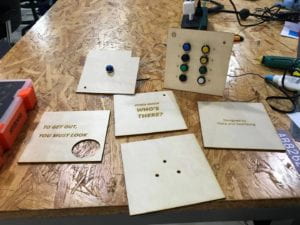
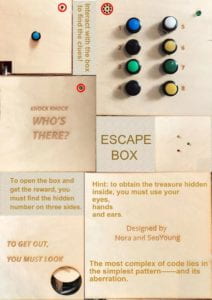
(The six sides)
After deciding on the ways of interaction we designed the six sides of the box and laser-cut it. It looked wonderful when it came out. There’s something special about the simplistic setting of buttons, LEDs and wood. The wiring and coding weren’t easy. We had to unplug and redesign three times for the password side alone. In the attemps we redesigned the wiring and curled the long lines short to make it clearer. It required much endurance and patience but we did it at last.
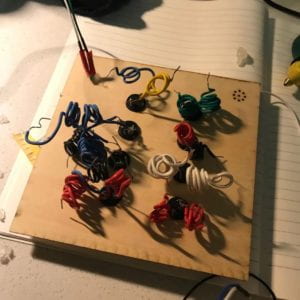
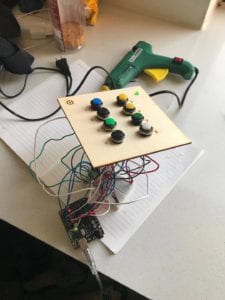
We did the laser-cut late, so we only had a very sketchy prototype for the user test. It thus required a lot of imagination for our users to know the use of our project. However, they were very generous and gave useful suggestions on how to improve our project: make the button bigger and the pattern more obvious.
This is the final product:
Our project ended up on Maker Faire!!! XD
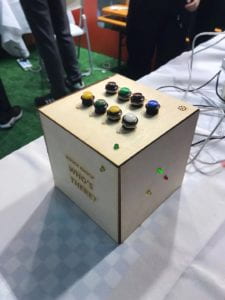
It was really exciting to see people show a lot of interest in this mysterious box. It amazes me how a simple small box would arouse so much curiosity in the visitors, especially kids. I guess it’s human nature to be attracted by puzzle and mystery. It turns out, however, our puzzles are a little too hard for one person to solve. It was often figured out by a group of people working together, and it was very interesting to see how these people communicate and think in different ways. One problem is that the buttons are too colorful and somewhat misleading with their colors, and the buzzer wasn’t loud enough in such a crowded faire. But in all it was very nice to be there to talk to people and see how they respond to our escape box.
I also found that sometimes even people can’t solve the puzzle themselves, they are very pleased to learn the solution. There is natural pleasure in discovering patterns and being surprised. In a world where most entertainments appeal to people’s comfort in not having to think, I hope our project evokes the joy of thinking, collaborating, and peeking into the unknown.